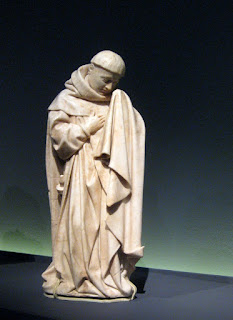For my birthday this year, we had lunch at Ledoyen, the wonderful restaurant I wrote about last year (click here to read). On the same day, I was invited to the press opening of a new exhibit at the Cluny Museum. Officially known as The Museum of the Middle Ages, the Cluny is housed in two exceptional Paris monuments: the Gallo-Roman baths and the 15th-century hotel of the abbey of Cluny. Founded in 1843, the museum's original collection was donated by private collector Alexandre Du Sommerard. Enriched over the centuries, the Cluny now houses a collection that spans the period from the 3rd-century Roman Gaul to the beginning of the 16th century. Among the treasures of the Cluny are the Roman baths; ancient textiles, including the famous Unicorn tapestries; gold and ivory objects; illuminated stain-glass windows; gothic sculpture; and an important collection of objects from the every-day life of the Middle Ages.
The current exhibit - "Alabaster Tears: the Mourners of the tomb of John the Fearless, Duke of Burgundy" - sounded a bit depressing for a birthday outing, especially since I've now attained and even passed un certain âge. Nonetheless, since the Cluny is one of my favorite museums in Paris, JR and I decided to stop by on our way to the restaurant.
Among the master works of 15th-century sculpture, the Burgundy mourners follow a tradition that goes back to depictions of sorrowful subjects on ancient sarcophagi. The 39 dazzling, delicately carved statues in the Cluny exhibit are approximately 42 centimeters high (16 inches). They were sculpted between 1456 and 1469 by Jean de La Huerta and Antoine Le Moiturier.
For more than 500 years, the figures have been affixed to the base of the tomb, which resides in the Musée des Beaux-Arts de Dijon. There, the pleurants as they are known in French, form a procession around the dead prince and his queen, Margaret of Bavaria. While the Dijon museum is undergoing renovations, however, the mourners, freed from their eternal vigil, have been touring the world. The Cluny is their last stop and probably the last time each sculpture can be individually viewed.
Representative of the elaborate royal funeral services that developed at the end of the Middle Ages, the mourners in the Cluny exhibit march one after the other in an ascending spiral, led by clerics and two angels. To illustrate the universality of death, the mourners are dressed alike in long, flowing robes. The diversity of life, however, is astonishingly captured by the remarkable detail of each sculpture, the variety of stances, and the expressions that reflect the different ways in which each person mourns. I recently lost my older sister and my father-in-law so death, sadly, has been on my mind. But, although the subject of the Cluny exhibit is death and mourning, the sculptures themselves are gloriously alive. They left me thinking not about loss, but about life and art and love.
The exhibit - whose title in French is Larmes D'Albâtre, Les pleurants du tombeau de Jean sans Peur, duc de Bourgogne - is on until June 3, 2013. If you are in Paris, don't miss it.
Musée de Cluny
6. place Paul Painlevé
75005 Paris
6. place Paul Painlevé
75005 Paris
A bientôt,
Geraldine






I love that place. How are the tapestries? David T.
ReplyDeleteThe tapestries are beautiful. Thanks for reminding me. I've put in a link above. Geraldine
DeleteYour website is really cool and this is a great inspiring article.
ReplyDeleteTrumpUSA